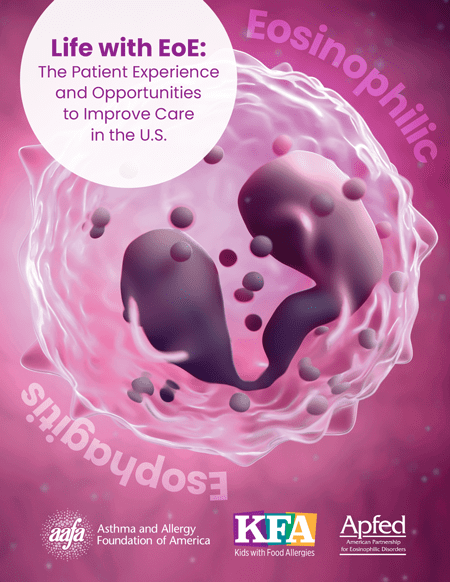Research

Life with Eosinophilic Esophagitis (EoE)
Eosinophilic esophagitis (EoE) is a chronic inflammatory condition of the esophagus (the tube that connects the mouth to the stomach). It is characterized by excessive numbers of eosinophils, a type of white blood cell, that accumulate in the esophagus in response to a trigger (often food or pollen). EoE can cause difficulty swallowing, food impactions (where food gets stuck in the throat), nausea, vomiting, reflux, stomach and chest pain, malnutrition, and weight loss.
The rates of EoE continue to rise significantly in the U.S. and around the world. The landscape of EoE care in the U.S. is evolving.
The Asthma and Allergy Foundation of America (AAFA) – the parent organization of Kids with Food Allergies (KFA) – and the American Partnership for Eosinophilic Disorders (APFED) conducted a multicomponent cross-sectional needs assessment study for EoE. The study aimed to understand the patient journey for EoE as well as health care providers’ awareness of and practice around EoE. Results from the study are published in a new report titled Life with EoE: The Patient Experience and Opportunities to Improve Care in the U.S.
The study sought to better understand current challenges and barriers to timely diagnosis, quality medical care, effective treatments, and access to resources for EoE. The objectives of the study were to:
- Understand the current state of EoE care in the U.S.
- Understand the patient journey for EoE
- Understand health care providers’ awareness of and practice around EoE
- Identify unmet needs for EoE patients and family members
- Identify unmet needs for health care providers caring for EoE patients
The Life with EoE report uses insights from the interviews (n=7), patient/caregiver survey (n=160) and HCP survey (n=110) to identify and provide opportunities for improving EoE care in the United States.
The report from this study summarizes the emotional, social, and financial impact on people with EoE and their caregivers.
Due to the breadth of topics covered by the survey, responses provided a great deal of insights into patient and caregiver experiences, beliefs, and knowledge. Throughout this report, the most notable data presented will focus on these key findings:
- Many patients experience delays in diagnosis for EoE, leading to delayed symptom relief, clinical care, and treatment.
- Signs and symptoms of EoE are not well-understood and mimic many other diseases, further delaying EoE diagnosis.
- Multidisciplinary care teams are common for EoE management.
- Adherence to treatment plans — particularly dietary therapies — poses the greatest challenge in managing EoE.
- EoE has a significant impact on social and emotional well-being.
- Patients/caregivers and health care providers acknowledge a greater need for support and resources for EoE.
Download PDFs
Life with EoE: The Patient Experience and Opportunities to Improve Care in the U.S. (3.66 MB, 64 pages)
Acknowledgements
Authors:
- Melanie Carver, Chief Mission Officer, AAFA
- Sanaz Eftekhari, Chief Business Development Officer, Vice President of Research, AAFA
- Hannah Jaffee, Research Manager, AAFA
- Cara Schmitt, Programs and Services Manager, APFED
- Mary Jo Strobel, Executive Director, APFED
The authors would like to acknowledge and express our appreciation to the following people for their input and guidance related to portions of the survey instruments, and/or review or design of this report:
- Joy Chang, MD, University of Michigan
- Nicole Gaghan, Art Director, AAFA
- Matthew Greenhawt, MD, Children’s Hospital Colorado
- Mark Holbreich, MD, Indianapolis, IN
- Denise Mack, Patient Advocate
- Jonathan Medernach, DO, University of Virginia
The Life with EoE report is an independent research project of the Asthma and Allergy Foundation of America and the American Partnership for Eosinophilic Disorders and made possible by support from Sanofi and Regeneron.
The views and opinions expressed in this report are those of the study participants and the AAFA and APFED authors and do not necessarily reflect the policies or positions of other individuals, organizations, or companies.













